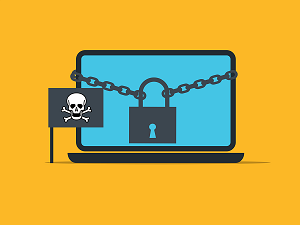
In the current era of escalating cybercrime, hackers are becoming increasingly sophisticated. They craft emails that seem legitimate and impersonate employees to gain unauthorized access to businesses. A single error, such as clicking on a malicious link, can significantly impact your business. Data loss is a serious threat. If you haven’t already implemented protective measures, we hope this article will underscore the importance of safeguarding your business immediately.
The Reality of Ransomware
The debate over the rise of ransomware may continue, but its threat is undeniable. Unprotected businesses risk losing their hard-earned money, valuable partnerships, and critical data to cybercriminals. Even if recovery is possible, the damage to your business and reputation can be severe.
Consider this stark statistic:
“60 percent of small companies go out of business within six months of falling victim to a data breach or cyber attack.”
— Cybercrime Magazine
Ransom demands are crippling small and medium-sized businesses (SMBs). The aftermath of a breach includes financial losses, loss of customer trust, and potential legal liabilities. According to IBM’s 2023 Cost of a Data Breach Report, the global average cost of a data breach in 2023 was USD 4.45 million, marking a 15% increase over the past three years. For SMBs, post-attack recovery is even more challenging due to limited resources. Implementing protective measures after an attack is often too little, too late.
Proactive Protection and Preparedness
It’s crucial to not only protect your business now but also plan for future incidents. Evaluate your current Managed Service Provider (MSP) practices, develop an Incident Response Plan (IRP) and a Disaster Recovery Plan (DRP), and ensure comprehensive coverage. Being prepared means partnering with an IT team that has a proven track record of proactive protection and efficient recovery in emergencies.
The Growing Threat of Business Email Compromise
The Federal Bureau of Investigation (FBI) highlights the growing threat of Business Email Compromise (BEC):
“Business Email Compromise: The $50 Billion Scam…The BEC scam has continued to evolve, targeting small local businesses to larger corporations, and personal transactions. Between December 2021 and December 2022, there was a 17% increase in identified global exposed losses.”
— Federal Bureau of Investigation (FBI)
Small businesses are frequent targets of cybercriminals, and a common misconception is that IT teams can easily handle these threats. However, businesses contributed over $50 billion to BEC scams, indicating the scale of this problem.
Understanding Smaller Ransom Demands
A concerning trend is the emergence of ransomware targeting smaller businesses with lower ransom demands:
“Researchers have identified a new strain of ransomware that dates back to 2019 and targets individuals and small businesses, demanding small ransoms from each client rather than the often million-dollar sums that typical ransomware actors ask.”
— DarkReading.com
These smaller attacks often fly under the radar, making it harder to prosecute the perpetrators. Cybercriminals believe that demanding smaller amounts from smaller businesses will avoid detection and legal consequences. Even minor attacks can have significant repercussions, especially for small healthcare organizations where patient data is valuable. The theft of such data can lead to further identity theft and financial losses.
The Financial Impact of Data Breaches on SMBs
In addition to the direct costs associated with data breaches, businesses must also consider the long-term financial impacts. According to the Ponemon Institute’s 2023 Cost of a Data Breach Report, companies can expect to incur additional hidden costs representing 11% of the total breach cost over the following two years. These costs include increased insurance premiums, lost business, and the expenses associated with improving security post-breach.
“The average total cost of a data breach for small businesses was $2.98 million in 2023, with significant hidden costs emerging in the aftermath.”
— Ponemon Institute
This statistic underscores the importance of not only addressing the immediate impacts of a breach but also preparing for the long-term financial ramifications.
Steps to Protect Your Business from Data Loss
All industries, especially healthcare and manufacturing, face heightened cyber threats. Healthcare alone saw 707 incidents last year, compromising 51.9 million records, with 95% of identity theft incidents stemming from compromised healthcare records.
To protect your business, we recommend:
- Partnering with a trusted MSP: Ensure they offer proactive data protection.
- Developing a robust Incident Response Plan (IRP): Keep it updated and detailed.
- Regularly reviewing and updating your IRP: Make sure it meets current standards.
Building a Culture of Cybersecurity Awareness
One of the most effective ways to protect your business is to build a culture of cybersecurity awareness among your employees. Regular training sessions on recognizing phishing attempts, understanding safe browsing practices, and knowing the steps to take in the event of a suspicious incident can significantly reduce the risk of a data breach.
Key elements of an effective cybersecurity training program include:
- Regular Training Sessions: Schedule ongoing training to keep employees updated on the latest threats.
- Phishing Simulations: Conduct regular phishing tests to help employees identify and avoid real phishing attempts.
- Clear Reporting Procedures: Ensure employees know how to report suspicious activities quickly and effectively.
Building a culture of cybersecurity awareness empowers your employees to act as the first line of defense against cyber threats, reducing the likelihood of human error leading to a data breach.
If you need assistance, we offer solutions tailored to prevent data loss and secure your business effectively. Contact us to protect your business today.


